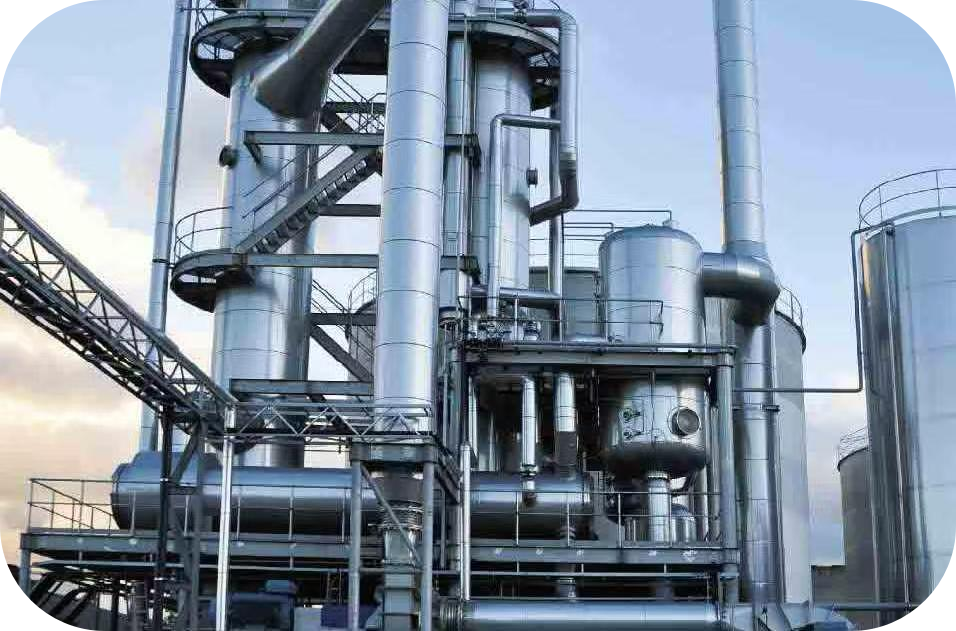Material Selection for MVR Evaporators
MVR (Mechanical Vapor Recompression) evaporators are widely used in chemical, pharmaceutical, food, and environmental protection (e.g., high-salinity wastewater treatment) industries as highly energy-efficient evaporation equipment. Their material selection directly determines the equipment's corrosion resistance, service life, operational stability, and cost. It requires comprehensive judgment based on multiple dimensions such as material characteristics, operating conditions, and economic factors. The following sections systematically outline the logic for material selection in MVR evaporators, to cover four key aspects: core selection principles, comparison of common materials, selection for typical application scenarios, and materials selection pitfalls.

I. Core Principles for MVR Evaporator Material Selection
Before selecting materials, it is essential to define the key parameters to ensure informed choices and avoid the pitfalls of selecting either unnecessarily expensive or inadequate low-cost options:
Material Corrosiveness: This is the primary determining factor in material selection. Clearly define the material composition (e.g., acids, alkalis, salts), concentration (e.g., 10% hydrochloric acid vs. 30%), and pH value (strongly acidic pH < 2; strongly alkaline pH > 12). Additionally, assess the presence of chloride ions (Cl⁻) or oxidizing agents (e.g., nitric acid, hydrogen peroxide). These can significantly influence corrosion behavior and easily cause pitting in stainless steel.
Operating Conditions: Evaluate the expected operating temperature (typically 40-100°C for evaporation processes, up to 120°C for high-salinity wastewater) and pressure (MVR often operates under vacuum or slightly positive pressure, with marginally higher discharge pressure at the compressor outlet). Consider also the presence of suspended solids, as crystalline particles can cause abrasion or erosion on internal surfaces.
Equipment Lifecycle and Maintenance Costs: Materials with superior corrosion resistance generally require higher initial investment but reduce long-term maintenance needs, such as welding repairs or part replacements. Conversely, low-cost materials might corrode and leak within one to two years, ultimately increasing the total cost of ownership through frequent downtime and replacement expenses.
Industry Compliance: Compliance requirements vary by industry. In the food and pharmaceutical sectors, materials must meet standards such as GB 4806.9 National Food Safety Standard: Metal Materials and Products for Food Contact (GMP) guidelines to prevent product contamination from heavy metal leaching. In environmental sectors, materials must also meet purity requirements for treated or recovered resources following wastewater treatment.
II. Material Comparisons and Recommendations for Typical Application Scenarios
Targeted selection based on industry-specific material characteristics ensures an optimal balance between performance and cost:
Food/Beverage Industry (e.g., sugar syrup, fruit juice, whey concentration):
Core Needs: No metal leaching, sanitary grade (easy to clean), resistance to weak acids.
Recommended Materials:
Evaporator Main Body: 304 Stainless Steel (internal walls polished to Ra ≤ 0.8µm, meeting sanitary standards).
If containing minor organic acids (e.g., citric acid): 316L Stainless Steel (enhanced corrosion resistance, preventing pitting).
Pharmaceutical Industry (e.g., medicinal liquid concentration, solvent recovery):
Core Needs: GMP compliance, low leaching, resistance to moderate corrosion (e.g., Cl⁻ containing buffer solutions).
Recommended Materials:
Main Equipment: 316L Stainless Steel (low carbon content reduces intergranular corrosion risk; internal walls electropolished).
If material contains high Cl⁻ (e.g., chloride-based medicinal liquids): 2507 Duplex Stainless Steel (avoids Cl⁻ induced pitting and stress corrosion cracking).
Environmental High-Salinity Wastewater Treatment (e.g., coal chemical, dyeing, electroplating wastewater):
Core Needs: Resistance to high Cl⁻ (typically 500-5000 ppm), resistance to salt crystal abrasion, resistance to certain acids/alkalis.
Recommended Materials:
Standard High-Salinity Wastewater (Cl⁻ < 1000 ppm, pH 4-10): 2507 Duplex Stainless Steel (optimal cost-performance).
High-Salinity, High-Acidity Wastewater (e.g., electroplating wastewater containing HCl, pH < 2): Titanium (TA2) (strong corrosion resistance, lower cost than Hastelloy).
Extreme Corrosion (e.g., containing concentrated nitric acid + high Cl⁻): Hastelloy C276 (the only viable resistant material, typically limited to critical components).
Chemical Industry (e.g., organic/inorganic salt concentration, such as ammonium sulfate, magnesium chloride):
Core Needs: Resistance to the inherent corrosiveness of the material (e.g., organic acids, high-concentration salts), temperature resistance.
Recommended Materials:
Dilute Organic Acids (e.g., acetic acid): 316L Stainless Steel.
High-Concentration Salt Solutions (e.g., saturated magnesium chloride): 2507 Duplex Stainless Steel or Titanium.
Strongly Oxidizing Materials (e.g., ammonium nitrate solution): Hastelloy C276 (prevents oxidative corrosion).
III. Material Selection Pitfalls and Recommendations
Selecting the right material requires more than choosing the strongest or cheapest option, as it demands a balanced understanding of performance, process conditions, and long term costs. The following common pitfalls and corresponding recommendations can help guide more effective and reliable material selection:
Blindly Pursuing Highly Corrosion-Resistant Materials:
For instance, using 2507 Duplex Steel in the food industry offers strong corrosion resistance but is often unnecessary, as the process media are typically not highly corrosive. This approach can lead to excessive investment without added value.
Recommendation: Perform material corrosion tests (e.g., coupon tests) under actual operating conditions before finalizing materials. A corrosion rate of ≤ 0.1 mm/year is generally acceptable.Neglecting the Impact of Welding Processes:
Improper welding can compromise even the best materials. For example, stainless steel (e.g., 316L) that is not solution annealed after welding becomes susceptible to intergranular corrosion. Similarly, titanium welding requires an inert gas shield to prevent oxidation and weld failure.
Recommendation: Select qualified manufacturers, specify welding procedures and subsequent inspections (e.g., penetrant testing, corrosion tests).Focusing Only on Initial Cost, Ignoring Maintenance Costs:
Choosing lower-grade materials such as 304 stainless steel for high-salinity wastewater applications may reduce initial costs but can result in Cl⁻ induced corrosion and leaks within one to two years. The resulting repair costs, downtime, component replacement, and contamination risk, can easily outweigh the initial savings.
Recommendation: Perform a lifecycle cost analysis that includes both the initial investment and long term maintenance (e.g., over 10 years). Prioritize materials offering the best overall cost-performance ratio rather than the lowest upfront cost.
In summary, material selection for MVR evaporators requires a tailored approach – focusing on material corrosiveness and operating conditions as the core factors, combined with industry compliance, budget constraints, and maintenance needs. Through experimental validation and lifecycle analysis, the most suitable materials should be selected to ensure long-term, stable operation of the equipment.

